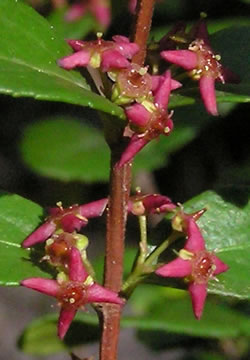Plant of the Week
 Range map of mountain-lover. States are colored green where the species may be found.
Range map of mountain-lover. States are colored green where the species may be found.
 Paxistima myrsinites in flower and with new leaf growth (light green). Photo © Al Schneider.
Paxistima myrsinites in flower and with new leaf growth (light green). Photo © Al Schneider.
 Close-up of the flowers of Paxistima myrsinites. Photo © Al Schneider.
Close-up of the flowers of Paxistima myrsinites. Photo © Al Schneider.
Mountain-lover (Paxistima myrsinites)
By Walter Fertig
The genus Paxistima in the bittersweet family (Celastraceae) contains just two extant species. Both are low-growing evergreen shrubs with small, opposite, leathery leaves and minute four-petaled flowers that occur singly or in compact clusters in the leaf axils. Canby’s mountain-lover (P. canbyi) has slender leaves and greenish-white flowers and is restricted to rich, rocky forests of the southern Appalachian Mountains in eastern North America. Its cousin, Mountain-lover or Oregon-box (P. myrsinites) differs in having elliptical leaves and blood red or maroon flowers and ranges across the western cordillera from Alaska to California and New Mexico. Additional species of Paxistima are known only from the fossil record. How the surviving species ended up in two disjunct population centers is not well known.
As its common name implies, Mountain-lover has a predilection for mountainous terrain. It is most abundant in mid-montane to subalpine zones where it grows under full to partial shade of conifers, oaks, and maples on rich rocky soils or talus. In recent years, Mountain-lover has become popular as a garden ornamental or accent plant. It can grow from cuttings or seed and does best on neutral to acid soils that are well drained. Some shade or protection from winter sun is beneficial for successful establishment.
Lewis and Clark first discovered mountain-lover on their westward expedition in 1805. Frederick Pursh initially described the species as a type of holly (genus Ilex in the holly family, Aquifoliaceae) based on its finely toothed evergreen leaves. Constantine Rafinesque later reclassified it in its own genus, Paxistima. The exact etymology and correct spelling of the genus have been debated for nearly two centuries. Most scholars assume the name comes from the Greek words “pachys” for thick (think of a thick-skinned elephant, or pachyderm) and stigma, in reference to the somewhat thickened stigma of the flower. Rafinesque and others have variously spelled the name as Pachistma, Pachystima, and Pachystigma, although Rafinesque’s original spelling of Paxistima is the name most widely accepted today. The species epithet, myrsinites, also comes from the Greek for “myrrh”, which the Mountain-lover’s tiny flowers are said to resemble in scent.


